Case Study on Joseph Russo
VerifiedAdded on 2023/04/21
|10
|2787
|123
AI Summary
This case study discusses the Central Line Associated Blood Stream Infection (CLABSI) in the patient Joseph Russo. It explores the causes, prevention methods, and management strategies for CLABSI. The study also provides recommendations for the care of Joseph.
Contribute Materials
Your contribution can guide someone’s learning journey. Share your
documents today.

Running head: CASE STUDY ON JOSEPH RUSSO
Case study on Joseph Russo
Name of the Student
Name of the University
Author Note
Case study on Joseph Russo
Name of the Student
Name of the University
Author Note
Secure Best Marks with AI Grader
Need help grading? Try our AI Grader for instant feedback on your assignments.
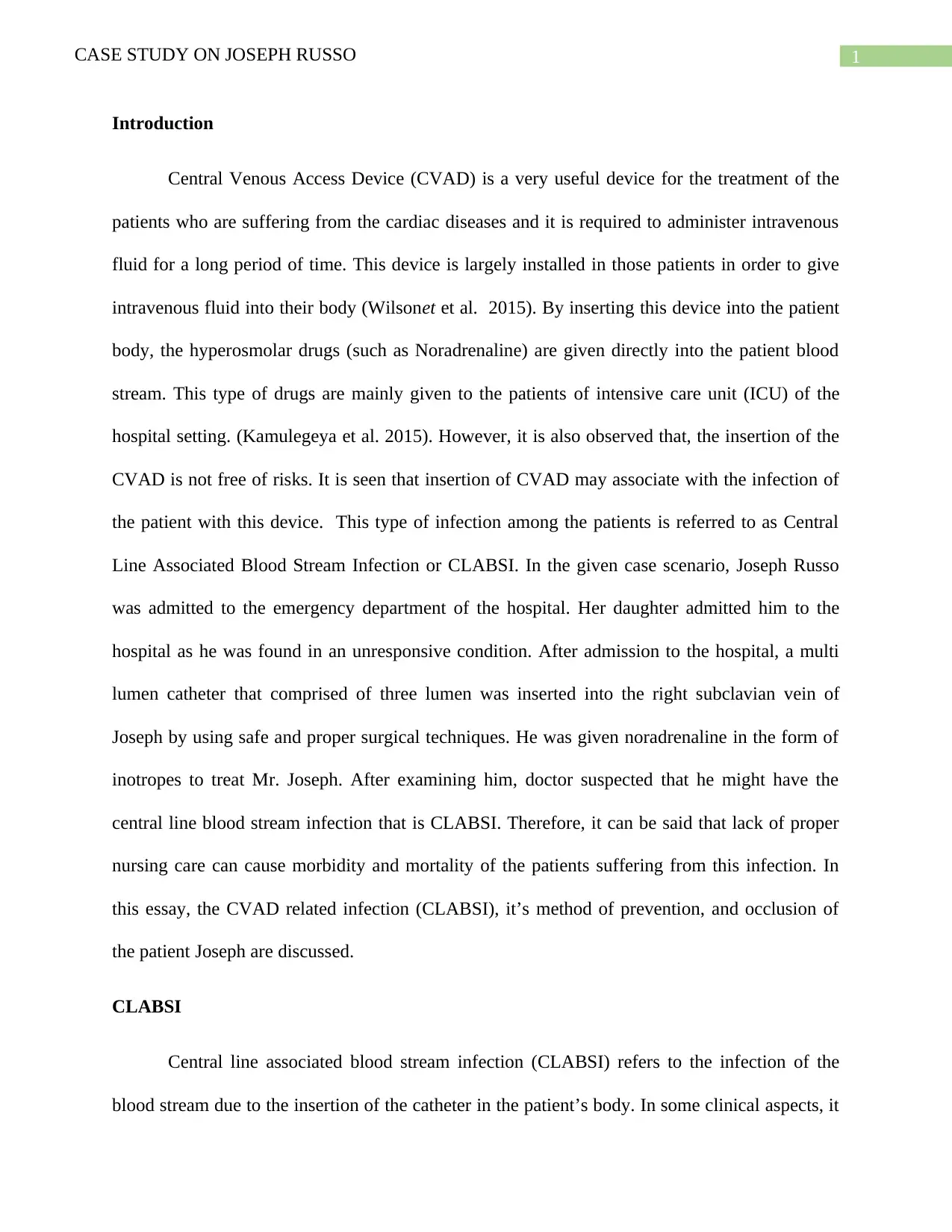
1CASE STUDY ON JOSEPH RUSSO
Introduction
Central Venous Access Device (CVAD) is a very useful device for the treatment of the
patients who are suffering from the cardiac diseases and it is required to administer intravenous
fluid for a long period of time. This device is largely installed in those patients in order to give
intravenous fluid into their body (Wilsonet et al. 2015). By inserting this device into the patient
body, the hyperosmolar drugs (such as Noradrenaline) are given directly into the patient blood
stream. This type of drugs are mainly given to the patients of intensive care unit (ICU) of the
hospital setting. (Kamulegeya et al. 2015). However, it is also observed that, the insertion of the
CVAD is not free of risks. It is seen that insertion of CVAD may associate with the infection of
the patient with this device. This type of infection among the patients is referred to as Central
Line Associated Blood Stream Infection or CLABSI. In the given case scenario, Joseph Russo
was admitted to the emergency department of the hospital. Her daughter admitted him to the
hospital as he was found in an unresponsive condition. After admission to the hospital, a multi
lumen catheter that comprised of three lumen was inserted into the right subclavian vein of
Joseph by using safe and proper surgical techniques. He was given noradrenaline in the form of
inotropes to treat Mr. Joseph. After examining him, doctor suspected that he might have the
central line blood stream infection that is CLABSI. Therefore, it can be said that lack of proper
nursing care can cause morbidity and mortality of the patients suffering from this infection. In
this essay, the CVAD related infection (CLABSI), it’s method of prevention, and occlusion of
the patient Joseph are discussed.
CLABSI
Central line associated blood stream infection (CLABSI) refers to the infection of the
blood stream due to the insertion of the catheter in the patient’s body. In some clinical aspects, it
Introduction
Central Venous Access Device (CVAD) is a very useful device for the treatment of the
patients who are suffering from the cardiac diseases and it is required to administer intravenous
fluid for a long period of time. This device is largely installed in those patients in order to give
intravenous fluid into their body (Wilsonet et al. 2015). By inserting this device into the patient
body, the hyperosmolar drugs (such as Noradrenaline) are given directly into the patient blood
stream. This type of drugs are mainly given to the patients of intensive care unit (ICU) of the
hospital setting. (Kamulegeya et al. 2015). However, it is also observed that, the insertion of the
CVAD is not free of risks. It is seen that insertion of CVAD may associate with the infection of
the patient with this device. This type of infection among the patients is referred to as Central
Line Associated Blood Stream Infection or CLABSI. In the given case scenario, Joseph Russo
was admitted to the emergency department of the hospital. Her daughter admitted him to the
hospital as he was found in an unresponsive condition. After admission to the hospital, a multi
lumen catheter that comprised of three lumen was inserted into the right subclavian vein of
Joseph by using safe and proper surgical techniques. He was given noradrenaline in the form of
inotropes to treat Mr. Joseph. After examining him, doctor suspected that he might have the
central line blood stream infection that is CLABSI. Therefore, it can be said that lack of proper
nursing care can cause morbidity and mortality of the patients suffering from this infection. In
this essay, the CVAD related infection (CLABSI), it’s method of prevention, and occlusion of
the patient Joseph are discussed.
CLABSI
Central line associated blood stream infection (CLABSI) refers to the infection of the
blood stream due to the insertion of the catheter in the patient’s body. In some clinical aspects, it
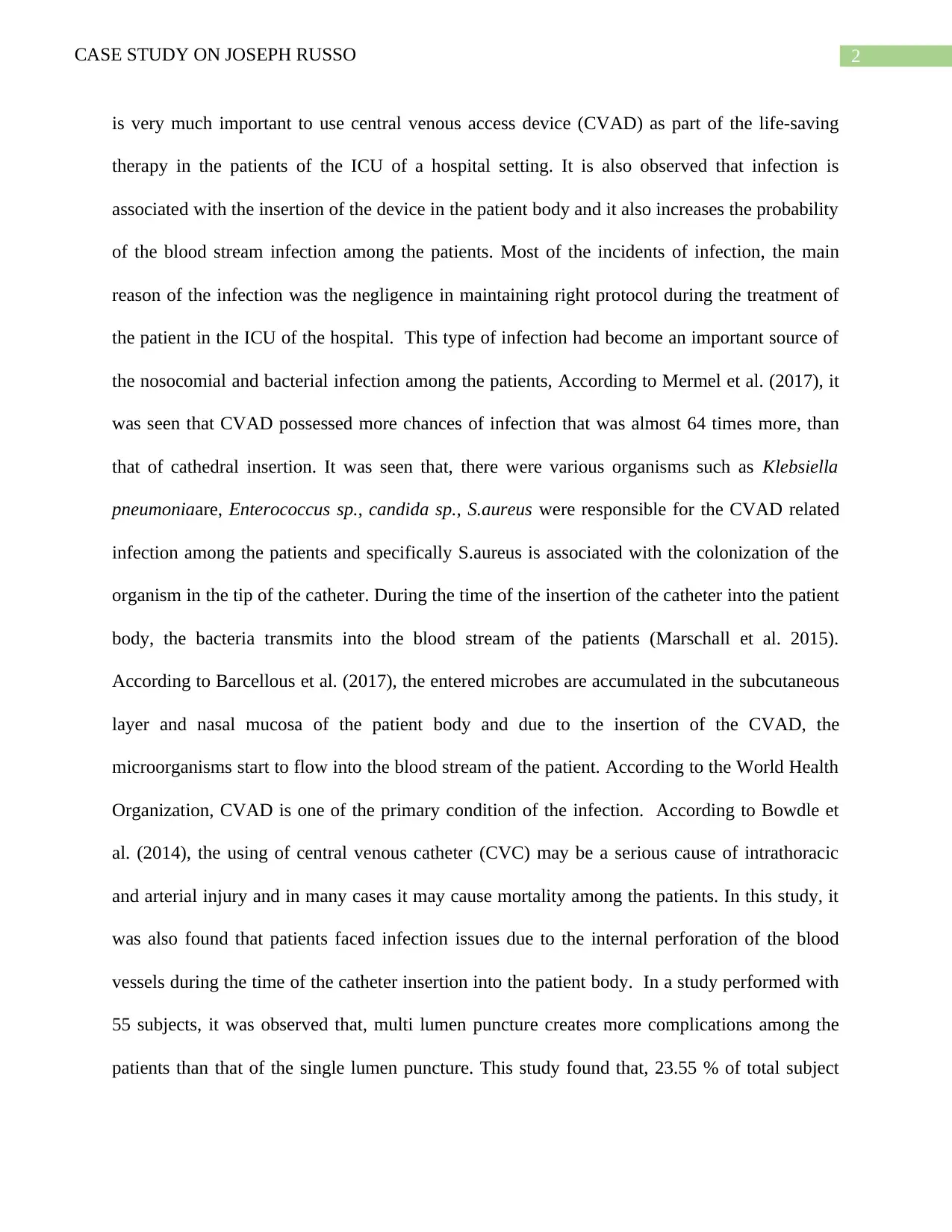
2CASE STUDY ON JOSEPH RUSSO
is very much important to use central venous access device (CVAD) as part of the life-saving
therapy in the patients of the ICU of a hospital setting. It is also observed that infection is
associated with the insertion of the device in the patient body and it also increases the probability
of the blood stream infection among the patients. Most of the incidents of infection, the main
reason of the infection was the negligence in maintaining right protocol during the treatment of
the patient in the ICU of the hospital. This type of infection had become an important source of
the nosocomial and bacterial infection among the patients, According to Mermel et al. (2017), it
was seen that CVAD possessed more chances of infection that was almost 64 times more, than
that of cathedral insertion. It was seen that, there were various organisms such as Klebsiella
pneumoniaare, Enterococcus sp., candida sp., S.aureus were responsible for the CVAD related
infection among the patients and specifically S.aureus is associated with the colonization of the
organism in the tip of the catheter. During the time of the insertion of the catheter into the patient
body, the bacteria transmits into the blood stream of the patients (Marschall et al. 2015).
According to Barcellous et al. (2017), the entered microbes are accumulated in the subcutaneous
layer and nasal mucosa of the patient body and due to the insertion of the CVAD, the
microorganisms start to flow into the blood stream of the patient. According to the World Health
Organization, CVAD is one of the primary condition of the infection. According to Bowdle et
al. (2014), the using of central venous catheter (CVC) may be a serious cause of intrathoracic
and arterial injury and in many cases it may cause mortality among the patients. In this study, it
was also found that patients faced infection issues due to the internal perforation of the blood
vessels during the time of the catheter insertion into the patient body. In a study performed with
55 subjects, it was observed that, multi lumen puncture creates more complications among the
patients than that of the single lumen puncture. This study found that, 23.55 % of total subject
is very much important to use central venous access device (CVAD) as part of the life-saving
therapy in the patients of the ICU of a hospital setting. It is also observed that infection is
associated with the insertion of the device in the patient body and it also increases the probability
of the blood stream infection among the patients. Most of the incidents of infection, the main
reason of the infection was the negligence in maintaining right protocol during the treatment of
the patient in the ICU of the hospital. This type of infection had become an important source of
the nosocomial and bacterial infection among the patients, According to Mermel et al. (2017), it
was seen that CVAD possessed more chances of infection that was almost 64 times more, than
that of cathedral insertion. It was seen that, there were various organisms such as Klebsiella
pneumoniaare, Enterococcus sp., candida sp., S.aureus were responsible for the CVAD related
infection among the patients and specifically S.aureus is associated with the colonization of the
organism in the tip of the catheter. During the time of the insertion of the catheter into the patient
body, the bacteria transmits into the blood stream of the patients (Marschall et al. 2015).
According to Barcellous et al. (2017), the entered microbes are accumulated in the subcutaneous
layer and nasal mucosa of the patient body and due to the insertion of the CVAD, the
microorganisms start to flow into the blood stream of the patient. According to the World Health
Organization, CVAD is one of the primary condition of the infection. According to Bowdle et
al. (2014), the using of central venous catheter (CVC) may be a serious cause of intrathoracic
and arterial injury and in many cases it may cause mortality among the patients. In this study, it
was also found that patients faced infection issues due to the internal perforation of the blood
vessels during the time of the catheter insertion into the patient body. In a study performed with
55 subjects, it was observed that, multi lumen puncture creates more complications among the
patients than that of the single lumen puncture. This study found that, 23.55 % of total subject
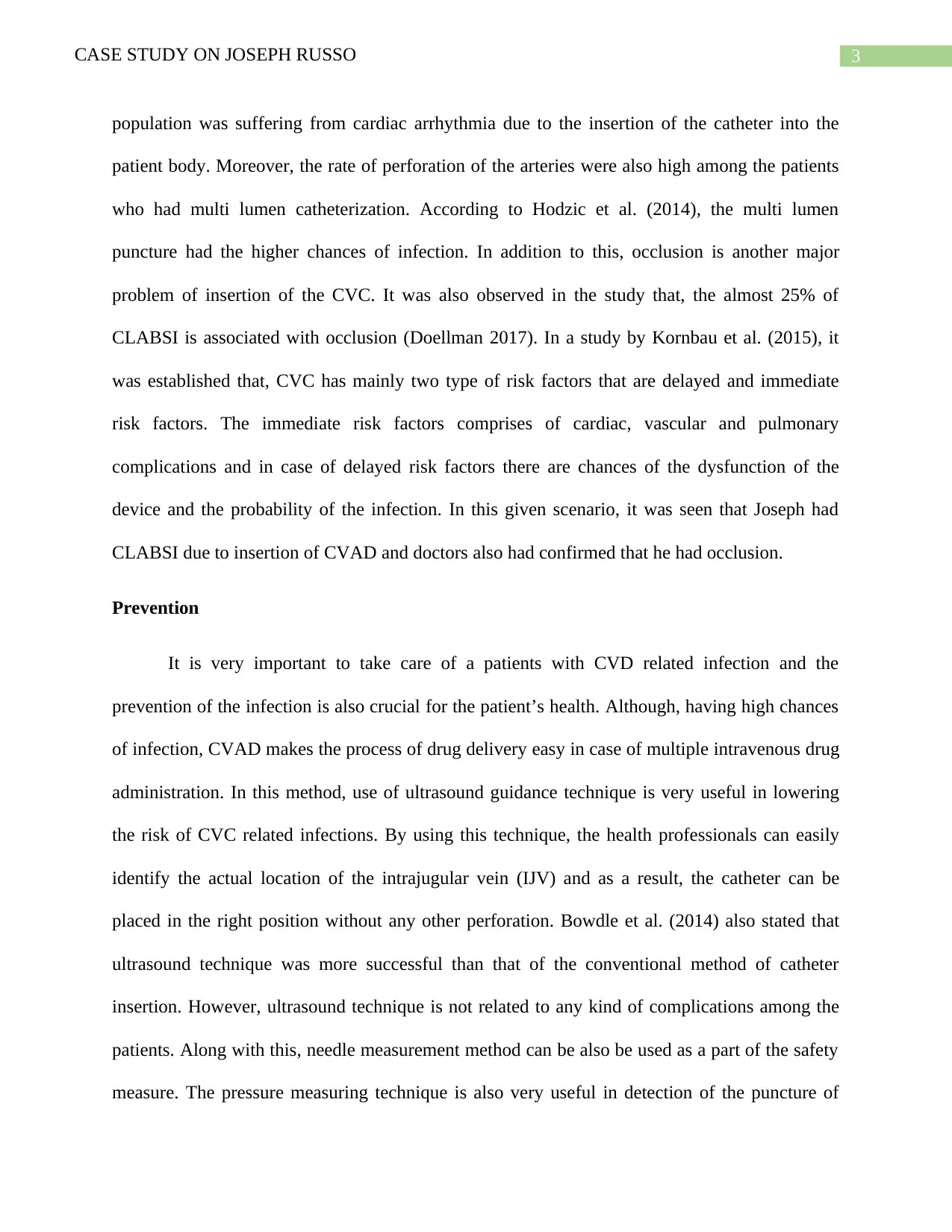
3CASE STUDY ON JOSEPH RUSSO
population was suffering from cardiac arrhythmia due to the insertion of the catheter into the
patient body. Moreover, the rate of perforation of the arteries were also high among the patients
who had multi lumen catheterization. According to Hodzic et al. (2014), the multi lumen
puncture had the higher chances of infection. In addition to this, occlusion is another major
problem of insertion of the CVC. It was also observed in the study that, the almost 25% of
CLABSI is associated with occlusion (Doellman 2017). In a study by Kornbau et al. (2015), it
was established that, CVC has mainly two type of risk factors that are delayed and immediate
risk factors. The immediate risk factors comprises of cardiac, vascular and pulmonary
complications and in case of delayed risk factors there are chances of the dysfunction of the
device and the probability of the infection. In this given scenario, it was seen that Joseph had
CLABSI due to insertion of CVAD and doctors also had confirmed that he had occlusion.
Prevention
It is very important to take care of a patients with CVD related infection and the
prevention of the infection is also crucial for the patient’s health. Although, having high chances
of infection, CVAD makes the process of drug delivery easy in case of multiple intravenous drug
administration. In this method, use of ultrasound guidance technique is very useful in lowering
the risk of CVC related infections. By using this technique, the health professionals can easily
identify the actual location of the intrajugular vein (IJV) and as a result, the catheter can be
placed in the right position without any other perforation. Bowdle et al. (2014) also stated that
ultrasound technique was more successful than that of the conventional method of catheter
insertion. However, ultrasound technique is not related to any kind of complications among the
patients. Along with this, needle measurement method can be also be used as a part of the safety
measure. The pressure measuring technique is also very useful in detection of the puncture of
population was suffering from cardiac arrhythmia due to the insertion of the catheter into the
patient body. Moreover, the rate of perforation of the arteries were also high among the patients
who had multi lumen catheterization. According to Hodzic et al. (2014), the multi lumen
puncture had the higher chances of infection. In addition to this, occlusion is another major
problem of insertion of the CVC. It was also observed in the study that, the almost 25% of
CLABSI is associated with occlusion (Doellman 2017). In a study by Kornbau et al. (2015), it
was established that, CVC has mainly two type of risk factors that are delayed and immediate
risk factors. The immediate risk factors comprises of cardiac, vascular and pulmonary
complications and in case of delayed risk factors there are chances of the dysfunction of the
device and the probability of the infection. In this given scenario, it was seen that Joseph had
CLABSI due to insertion of CVAD and doctors also had confirmed that he had occlusion.
Prevention
It is very important to take care of a patients with CVD related infection and the
prevention of the infection is also crucial for the patient’s health. Although, having high chances
of infection, CVAD makes the process of drug delivery easy in case of multiple intravenous drug
administration. In this method, use of ultrasound guidance technique is very useful in lowering
the risk of CVC related infections. By using this technique, the health professionals can easily
identify the actual location of the intrajugular vein (IJV) and as a result, the catheter can be
placed in the right position without any other perforation. Bowdle et al. (2014) also stated that
ultrasound technique was more successful than that of the conventional method of catheter
insertion. However, ultrasound technique is not related to any kind of complications among the
patients. Along with this, needle measurement method can be also be used as a part of the safety
measure. The pressure measuring technique is also very useful in detection of the puncture of
Secure Best Marks with AI Grader
Need help grading? Try our AI Grader for instant feedback on your assignments.
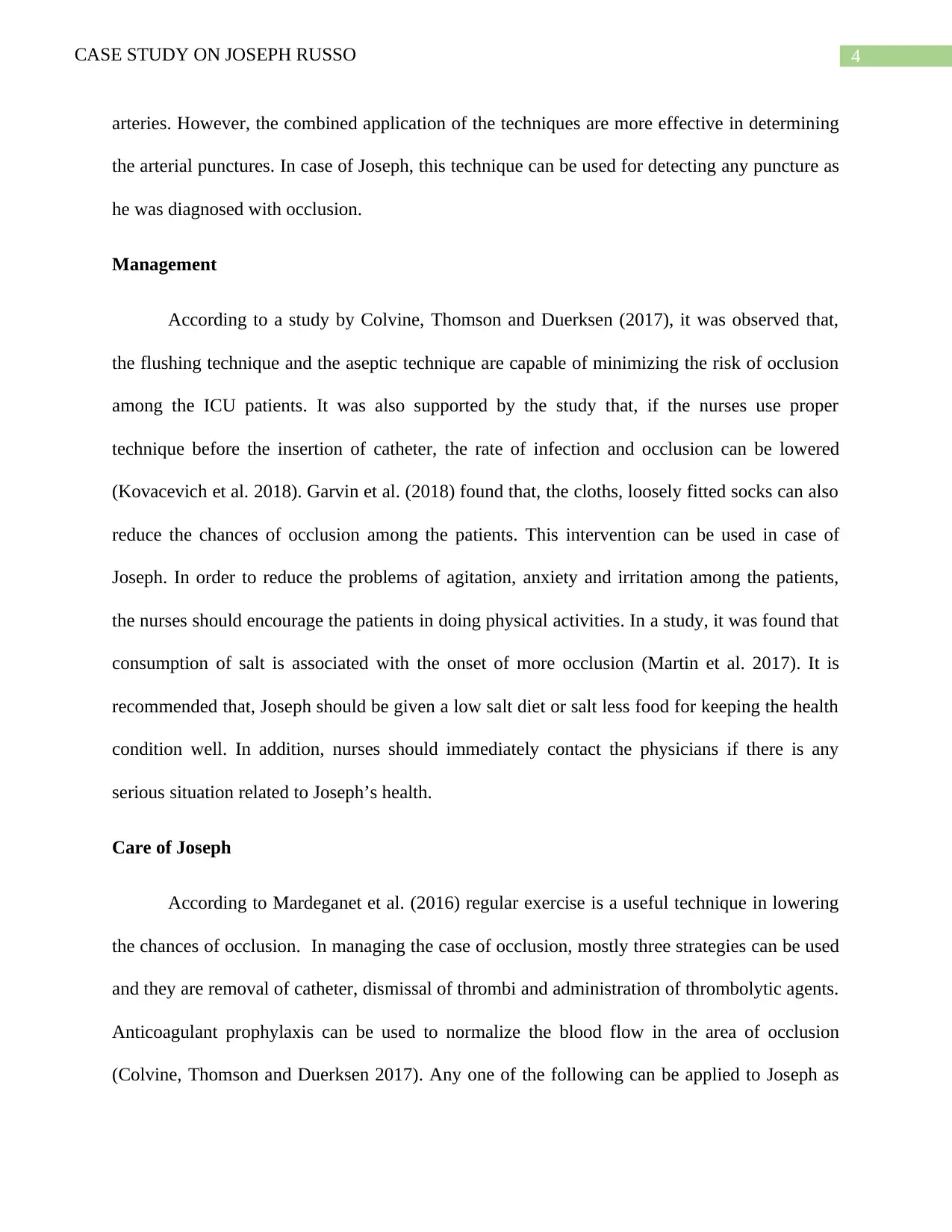
4CASE STUDY ON JOSEPH RUSSO
arteries. However, the combined application of the techniques are more effective in determining
the arterial punctures. In case of Joseph, this technique can be used for detecting any puncture as
he was diagnosed with occlusion.
Management
According to a study by Colvine, Thomson and Duerksen (2017), it was observed that,
the flushing technique and the aseptic technique are capable of minimizing the risk of occlusion
among the ICU patients. It was also supported by the study that, if the nurses use proper
technique before the insertion of catheter, the rate of infection and occlusion can be lowered
(Kovacevich et al. 2018). Garvin et al. (2018) found that, the cloths, loosely fitted socks can also
reduce the chances of occlusion among the patients. This intervention can be used in case of
Joseph. In order to reduce the problems of agitation, anxiety and irritation among the patients,
the nurses should encourage the patients in doing physical activities. In a study, it was found that
consumption of salt is associated with the onset of more occlusion (Martin et al. 2017). It is
recommended that, Joseph should be given a low salt diet or salt less food for keeping the health
condition well. In addition, nurses should immediately contact the physicians if there is any
serious situation related to Joseph’s health.
Care of Joseph
According to Mardeganet et al. (2016) regular exercise is a useful technique in lowering
the chances of occlusion. In managing the case of occlusion, mostly three strategies can be used
and they are removal of catheter, dismissal of thrombi and administration of thrombolytic agents.
Anticoagulant prophylaxis can be used to normalize the blood flow in the area of occlusion
(Colvine, Thomson and Duerksen 2017). Any one of the following can be applied to Joseph as
arteries. However, the combined application of the techniques are more effective in determining
the arterial punctures. In case of Joseph, this technique can be used for detecting any puncture as
he was diagnosed with occlusion.
Management
According to a study by Colvine, Thomson and Duerksen (2017), it was observed that,
the flushing technique and the aseptic technique are capable of minimizing the risk of occlusion
among the ICU patients. It was also supported by the study that, if the nurses use proper
technique before the insertion of catheter, the rate of infection and occlusion can be lowered
(Kovacevich et al. 2018). Garvin et al. (2018) found that, the cloths, loosely fitted socks can also
reduce the chances of occlusion among the patients. This intervention can be used in case of
Joseph. In order to reduce the problems of agitation, anxiety and irritation among the patients,
the nurses should encourage the patients in doing physical activities. In a study, it was found that
consumption of salt is associated with the onset of more occlusion (Martin et al. 2017). It is
recommended that, Joseph should be given a low salt diet or salt less food for keeping the health
condition well. In addition, nurses should immediately contact the physicians if there is any
serious situation related to Joseph’s health.
Care of Joseph
According to Mardeganet et al. (2016) regular exercise is a useful technique in lowering
the chances of occlusion. In managing the case of occlusion, mostly three strategies can be used
and they are removal of catheter, dismissal of thrombi and administration of thrombolytic agents.
Anticoagulant prophylaxis can be used to normalize the blood flow in the area of occlusion
(Colvine, Thomson and Duerksen 2017). Any one of the following can be applied to Joseph as
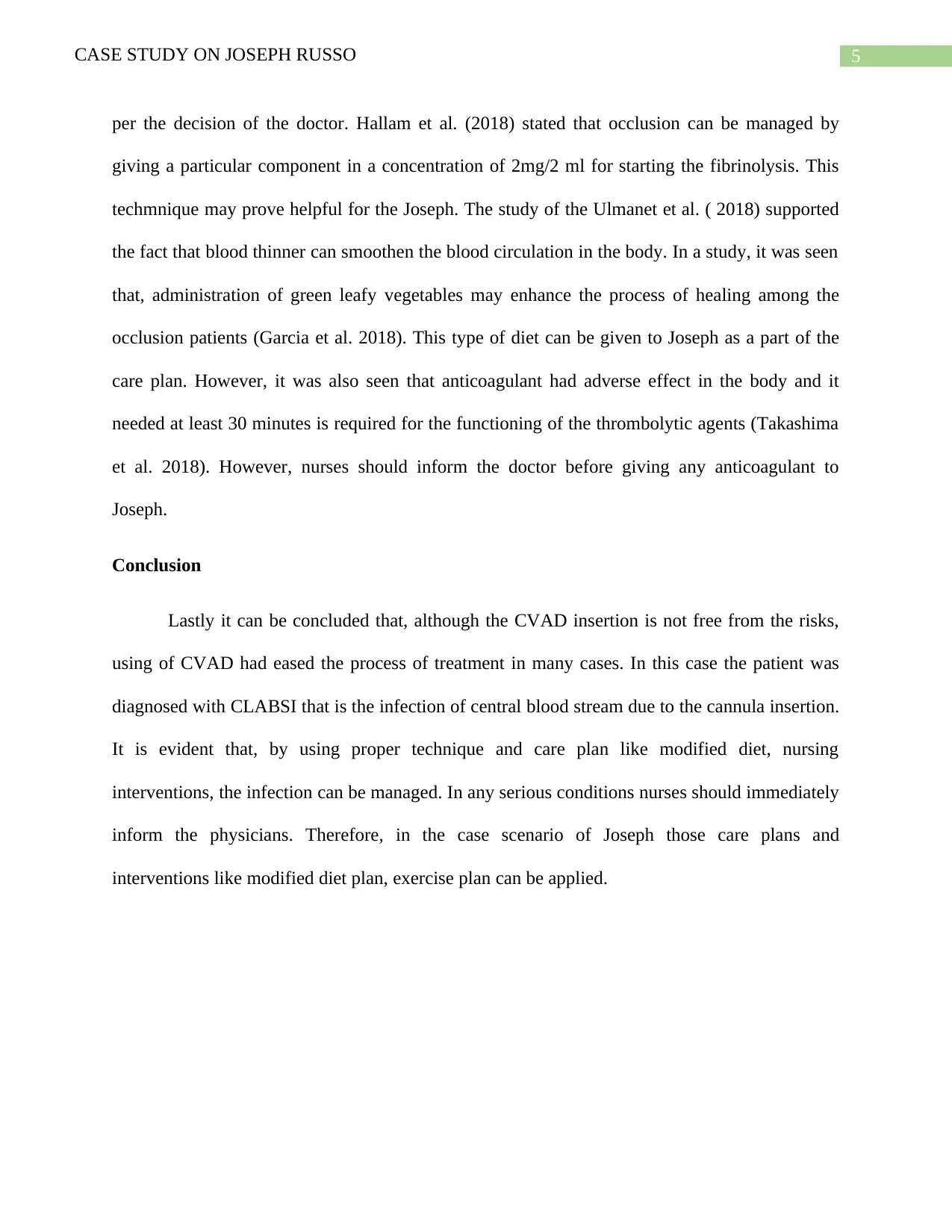
5CASE STUDY ON JOSEPH RUSSO
per the decision of the doctor. Hallam et al. (2018) stated that occlusion can be managed by
giving a particular component in a concentration of 2mg/2 ml for starting the fibrinolysis. This
techmnique may prove helpful for the Joseph. The study of the Ulmanet et al. ( 2018) supported
the fact that blood thinner can smoothen the blood circulation in the body. In a study, it was seen
that, administration of green leafy vegetables may enhance the process of healing among the
occlusion patients (Garcia et al. 2018). This type of diet can be given to Joseph as a part of the
care plan. However, it was also seen that anticoagulant had adverse effect in the body and it
needed at least 30 minutes is required for the functioning of the thrombolytic agents (Takashima
et al. 2018). However, nurses should inform the doctor before giving any anticoagulant to
Joseph.
Conclusion
Lastly it can be concluded that, although the CVAD insertion is not free from the risks,
using of CVAD had eased the process of treatment in many cases. In this case the patient was
diagnosed with CLABSI that is the infection of central blood stream due to the cannula insertion.
It is evident that, by using proper technique and care plan like modified diet, nursing
interventions, the infection can be managed. In any serious conditions nurses should immediately
inform the physicians. Therefore, in the case scenario of Joseph those care plans and
interventions like modified diet plan, exercise plan can be applied.
per the decision of the doctor. Hallam et al. (2018) stated that occlusion can be managed by
giving a particular component in a concentration of 2mg/2 ml for starting the fibrinolysis. This
techmnique may prove helpful for the Joseph. The study of the Ulmanet et al. ( 2018) supported
the fact that blood thinner can smoothen the blood circulation in the body. In a study, it was seen
that, administration of green leafy vegetables may enhance the process of healing among the
occlusion patients (Garcia et al. 2018). This type of diet can be given to Joseph as a part of the
care plan. However, it was also seen that anticoagulant had adverse effect in the body and it
needed at least 30 minutes is required for the functioning of the thrombolytic agents (Takashima
et al. 2018). However, nurses should inform the doctor before giving any anticoagulant to
Joseph.
Conclusion
Lastly it can be concluded that, although the CVAD insertion is not free from the risks,
using of CVAD had eased the process of treatment in many cases. In this case the patient was
diagnosed with CLABSI that is the infection of central blood stream due to the cannula insertion.
It is evident that, by using proper technique and care plan like modified diet, nursing
interventions, the infection can be managed. In any serious conditions nurses should immediately
inform the physicians. Therefore, in the case scenario of Joseph those care plans and
interventions like modified diet plan, exercise plan can be applied.
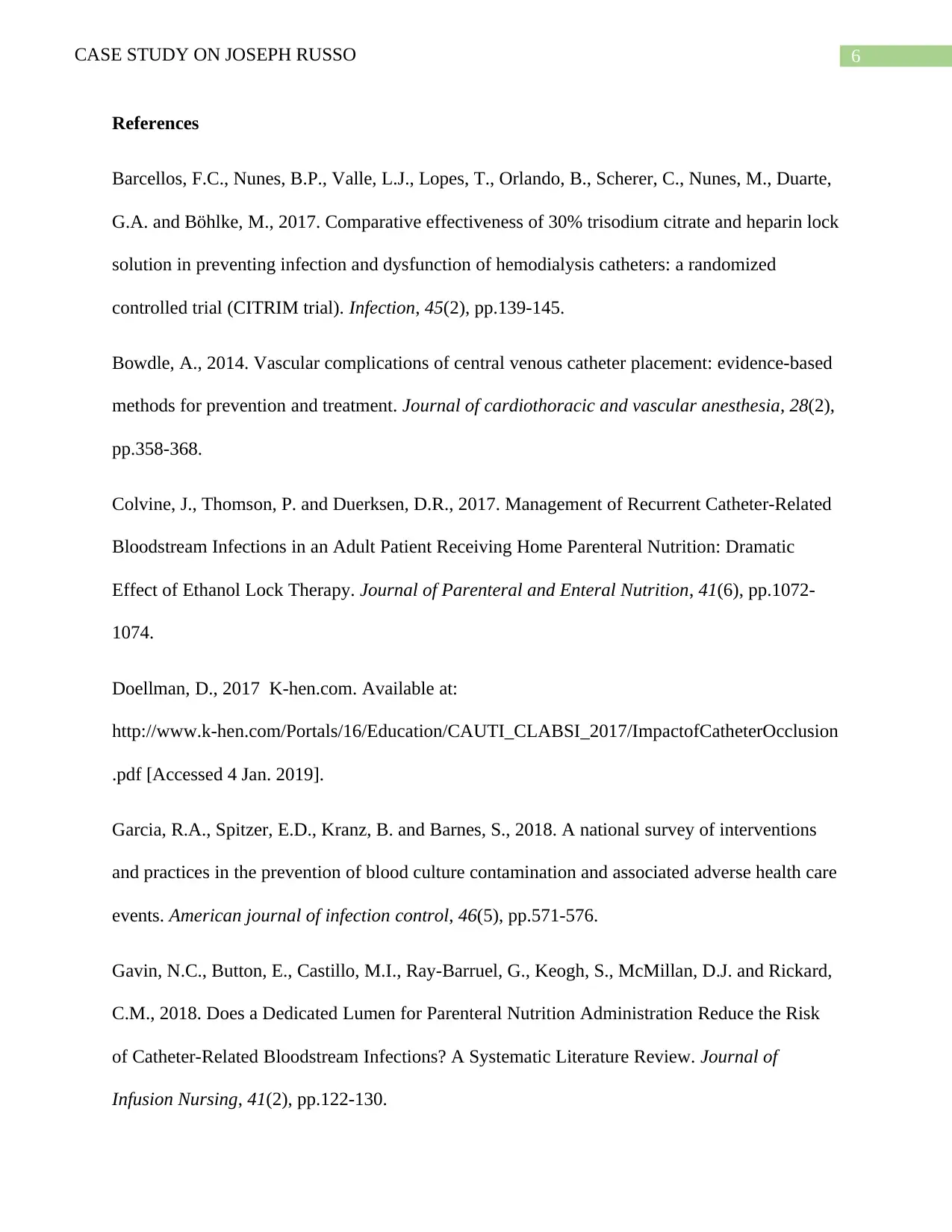
6CASE STUDY ON JOSEPH RUSSO
References
Barcellos, F.C., Nunes, B.P., Valle, L.J., Lopes, T., Orlando, B., Scherer, C., Nunes, M., Duarte,
G.A. and Böhlke, M., 2017. Comparative effectiveness of 30% trisodium citrate and heparin lock
solution in preventing infection and dysfunction of hemodialysis catheters: a randomized
controlled trial (CITRIM trial). Infection, 45(2), pp.139-145.
Bowdle, A., 2014. Vascular complications of central venous catheter placement: evidence-based
methods for prevention and treatment. Journal of cardiothoracic and vascular anesthesia, 28(2),
pp.358-368.
Colvine, J., Thomson, P. and Duerksen, D.R., 2017. Management of Recurrent Catheter‐Related
Bloodstream Infections in an Adult Patient Receiving Home Parenteral Nutrition: Dramatic
Effect of Ethanol Lock Therapy. Journal of Parenteral and Enteral Nutrition, 41(6), pp.1072-
1074.
Doellman, D., 2017 K-hen.com. Available at:
http://www.k-hen.com/Portals/16/Education/CAUTI_CLABSI_2017/ImpactofCatheterOcclusion
.pdf [Accessed 4 Jan. 2019].
Garcia, R.A., Spitzer, E.D., Kranz, B. and Barnes, S., 2018. A national survey of interventions
and practices in the prevention of blood culture contamination and associated adverse health care
events. American journal of infection control, 46(5), pp.571-576.
Gavin, N.C., Button, E., Castillo, M.I., Ray-Barruel, G., Keogh, S., McMillan, D.J. and Rickard,
C.M., 2018. Does a Dedicated Lumen for Parenteral Nutrition Administration Reduce the Risk
of Catheter-Related Bloodstream Infections? A Systematic Literature Review. Journal of
Infusion Nursing, 41(2), pp.122-130.
References
Barcellos, F.C., Nunes, B.P., Valle, L.J., Lopes, T., Orlando, B., Scherer, C., Nunes, M., Duarte,
G.A. and Böhlke, M., 2017. Comparative effectiveness of 30% trisodium citrate and heparin lock
solution in preventing infection and dysfunction of hemodialysis catheters: a randomized
controlled trial (CITRIM trial). Infection, 45(2), pp.139-145.
Bowdle, A., 2014. Vascular complications of central venous catheter placement: evidence-based
methods for prevention and treatment. Journal of cardiothoracic and vascular anesthesia, 28(2),
pp.358-368.
Colvine, J., Thomson, P. and Duerksen, D.R., 2017. Management of Recurrent Catheter‐Related
Bloodstream Infections in an Adult Patient Receiving Home Parenteral Nutrition: Dramatic
Effect of Ethanol Lock Therapy. Journal of Parenteral and Enteral Nutrition, 41(6), pp.1072-
1074.
Doellman, D., 2017 K-hen.com. Available at:
http://www.k-hen.com/Portals/16/Education/CAUTI_CLABSI_2017/ImpactofCatheterOcclusion
.pdf [Accessed 4 Jan. 2019].
Garcia, R.A., Spitzer, E.D., Kranz, B. and Barnes, S., 2018. A national survey of interventions
and practices in the prevention of blood culture contamination and associated adverse health care
events. American journal of infection control, 46(5), pp.571-576.
Gavin, N.C., Button, E., Castillo, M.I., Ray-Barruel, G., Keogh, S., McMillan, D.J. and Rickard,
C.M., 2018. Does a Dedicated Lumen for Parenteral Nutrition Administration Reduce the Risk
of Catheter-Related Bloodstream Infections? A Systematic Literature Review. Journal of
Infusion Nursing, 41(2), pp.122-130.
Paraphrase This Document
Need a fresh take? Get an instant paraphrase of this document with our AI Paraphraser
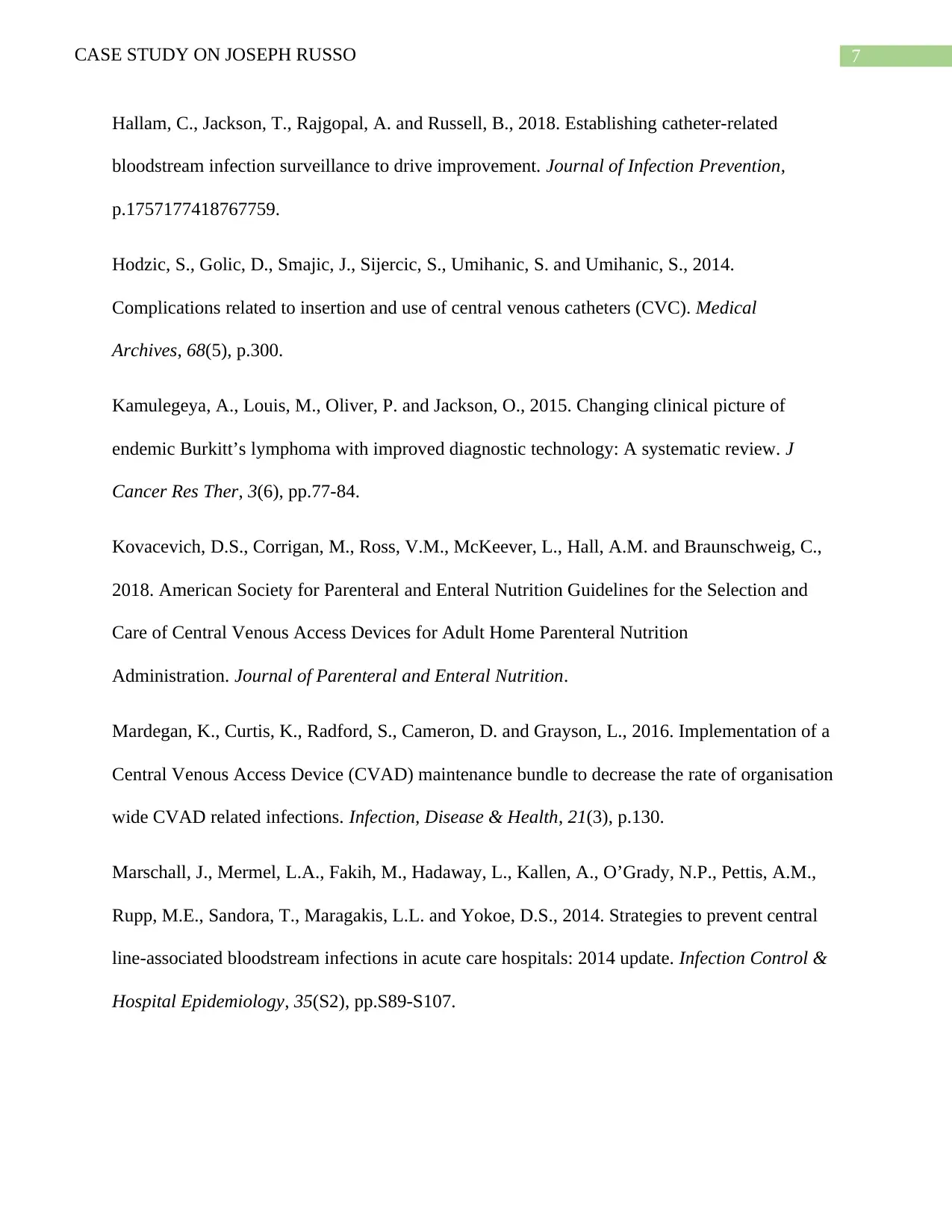
7CASE STUDY ON JOSEPH RUSSO
Hallam, C., Jackson, T., Rajgopal, A. and Russell, B., 2018. Establishing catheter-related
bloodstream infection surveillance to drive improvement. Journal of Infection Prevention,
p.1757177418767759.
Hodzic, S., Golic, D., Smajic, J., Sijercic, S., Umihanic, S. and Umihanic, S., 2014.
Complications related to insertion and use of central venous catheters (CVC). Medical
Archives, 68(5), p.300.
Kamulegeya, A., Louis, M., Oliver, P. and Jackson, O., 2015. Changing clinical picture of
endemic Burkitt’s lymphoma with improved diagnostic technology: A systematic review. J
Cancer Res Ther, 3(6), pp.77-84.
Kovacevich, D.S., Corrigan, M., Ross, V.M., McKeever, L., Hall, A.M. and Braunschweig, C.,
2018. American Society for Parenteral and Enteral Nutrition Guidelines for the Selection and
Care of Central Venous Access Devices for Adult Home Parenteral Nutrition
Administration. Journal of Parenteral and Enteral Nutrition.
Mardegan, K., Curtis, K., Radford, S., Cameron, D. and Grayson, L., 2016. Implementation of a
Central Venous Access Device (CVAD) maintenance bundle to decrease the rate of organisation
wide CVAD related infections. Infection, Disease & Health, 21(3), p.130.
Marschall, J., Mermel, L.A., Fakih, M., Hadaway, L., Kallen, A., O’Grady, N.P., Pettis, A.M.,
Rupp, M.E., Sandora, T., Maragakis, L.L. and Yokoe, D.S., 2014. Strategies to prevent central
line-associated bloodstream infections in acute care hospitals: 2014 update. Infection Control &
Hospital Epidemiology, 35(S2), pp.S89-S107.
Hallam, C., Jackson, T., Rajgopal, A. and Russell, B., 2018. Establishing catheter-related
bloodstream infection surveillance to drive improvement. Journal of Infection Prevention,
p.1757177418767759.
Hodzic, S., Golic, D., Smajic, J., Sijercic, S., Umihanic, S. and Umihanic, S., 2014.
Complications related to insertion and use of central venous catheters (CVC). Medical
Archives, 68(5), p.300.
Kamulegeya, A., Louis, M., Oliver, P. and Jackson, O., 2015. Changing clinical picture of
endemic Burkitt’s lymphoma with improved diagnostic technology: A systematic review. J
Cancer Res Ther, 3(6), pp.77-84.
Kovacevich, D.S., Corrigan, M., Ross, V.M., McKeever, L., Hall, A.M. and Braunschweig, C.,
2018. American Society for Parenteral and Enteral Nutrition Guidelines for the Selection and
Care of Central Venous Access Devices for Adult Home Parenteral Nutrition
Administration. Journal of Parenteral and Enteral Nutrition.
Mardegan, K., Curtis, K., Radford, S., Cameron, D. and Grayson, L., 2016. Implementation of a
Central Venous Access Device (CVAD) maintenance bundle to decrease the rate of organisation
wide CVAD related infections. Infection, Disease & Health, 21(3), p.130.
Marschall, J., Mermel, L.A., Fakih, M., Hadaway, L., Kallen, A., O’Grady, N.P., Pettis, A.M.,
Rupp, M.E., Sandora, T., Maragakis, L.L. and Yokoe, D.S., 2014. Strategies to prevent central
line-associated bloodstream infections in acute care hospitals: 2014 update. Infection Control &
Hospital Epidemiology, 35(S2), pp.S89-S107.
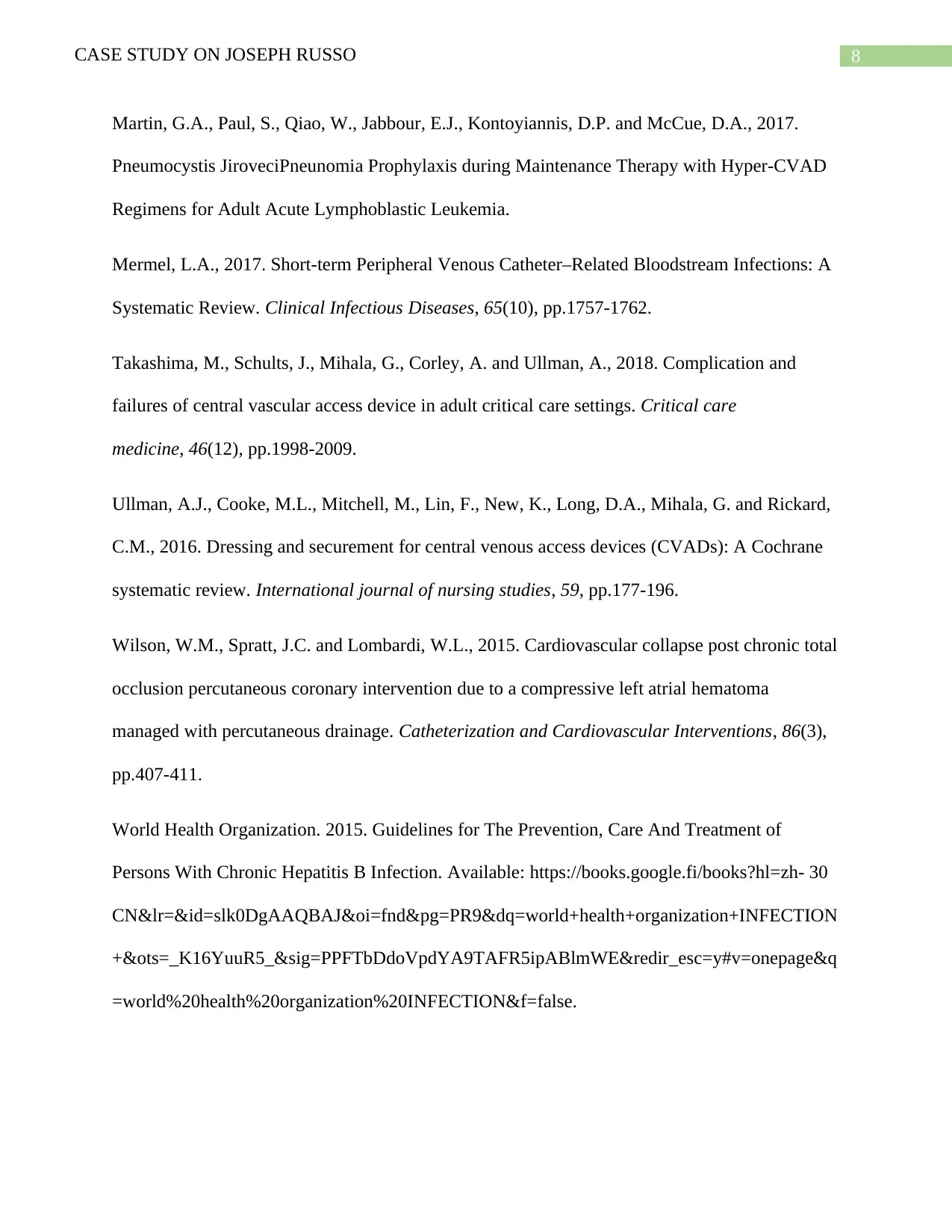
8CASE STUDY ON JOSEPH RUSSO
Martin, G.A., Paul, S., Qiao, W., Jabbour, E.J., Kontoyiannis, D.P. and McCue, D.A., 2017.
Pneumocystis JiroveciPneunomia Prophylaxis during Maintenance Therapy with Hyper-CVAD
Regimens for Adult Acute Lymphoblastic Leukemia.
Mermel, L.A., 2017. Short-term Peripheral Venous Catheter–Related Bloodstream Infections: A
Systematic Review. Clinical Infectious Diseases, 65(10), pp.1757-1762.
Takashima, M., Schults, J., Mihala, G., Corley, A. and Ullman, A., 2018. Complication and
failures of central vascular access device in adult critical care settings. Critical care
medicine, 46(12), pp.1998-2009.
Ullman, A.J., Cooke, M.L., Mitchell, M., Lin, F., New, K., Long, D.A., Mihala, G. and Rickard,
C.M., 2016. Dressing and securement for central venous access devices (CVADs): A Cochrane
systematic review. International journal of nursing studies, 59, pp.177-196.
Wilson, W.M., Spratt, J.C. and Lombardi, W.L., 2015. Cardiovascular collapse post chronic total
occlusion percutaneous coronary intervention due to a compressive left atrial hematoma
managed with percutaneous drainage. Catheterization and Cardiovascular Interventions, 86(3),
pp.407-411.
World Health Organization. 2015. Guidelines for The Prevention, Care And Treatment of
Persons With Chronic Hepatitis B Infection. Available: https://books.google.fi/books?hl=zh- 30
CN&lr=&id=slk0DgAAQBAJ&oi=fnd&pg=PR9&dq=world+health+organization+INFECTION
+&ots=_K16YuuR5_&sig=PPFTbDdoVpdYA9TAFR5ipABlmWE&redir_esc=y#v=onepage&q
=world%20health%20organization%20INFECTION&f=false.
Martin, G.A., Paul, S., Qiao, W., Jabbour, E.J., Kontoyiannis, D.P. and McCue, D.A., 2017.
Pneumocystis JiroveciPneunomia Prophylaxis during Maintenance Therapy with Hyper-CVAD
Regimens for Adult Acute Lymphoblastic Leukemia.
Mermel, L.A., 2017. Short-term Peripheral Venous Catheter–Related Bloodstream Infections: A
Systematic Review. Clinical Infectious Diseases, 65(10), pp.1757-1762.
Takashima, M., Schults, J., Mihala, G., Corley, A. and Ullman, A., 2018. Complication and
failures of central vascular access device in adult critical care settings. Critical care
medicine, 46(12), pp.1998-2009.
Ullman, A.J., Cooke, M.L., Mitchell, M., Lin, F., New, K., Long, D.A., Mihala, G. and Rickard,
C.M., 2016. Dressing and securement for central venous access devices (CVADs): A Cochrane
systematic review. International journal of nursing studies, 59, pp.177-196.
Wilson, W.M., Spratt, J.C. and Lombardi, W.L., 2015. Cardiovascular collapse post chronic total
occlusion percutaneous coronary intervention due to a compressive left atrial hematoma
managed with percutaneous drainage. Catheterization and Cardiovascular Interventions, 86(3),
pp.407-411.
World Health Organization. 2015. Guidelines for The Prevention, Care And Treatment of
Persons With Chronic Hepatitis B Infection. Available: https://books.google.fi/books?hl=zh- 30
CN&lr=&id=slk0DgAAQBAJ&oi=fnd&pg=PR9&dq=world+health+organization+INFECTION
+&ots=_K16YuuR5_&sig=PPFTbDdoVpdYA9TAFR5ipABlmWE&redir_esc=y#v=onepage&q
=world%20health%20organization%20INFECTION&f=false.

9CASE STUDY ON JOSEPH RUSSO
1 out of 10
Related Documents
Your All-in-One AI-Powered Toolkit for Academic Success.
+13062052269
info@desklib.com
Available 24*7 on WhatsApp / Email
![[object Object]](/_next/static/media/star-bottom.7253800d.svg)
Unlock your academic potential
© 2024 | Zucol Services PVT LTD | All rights reserved.





